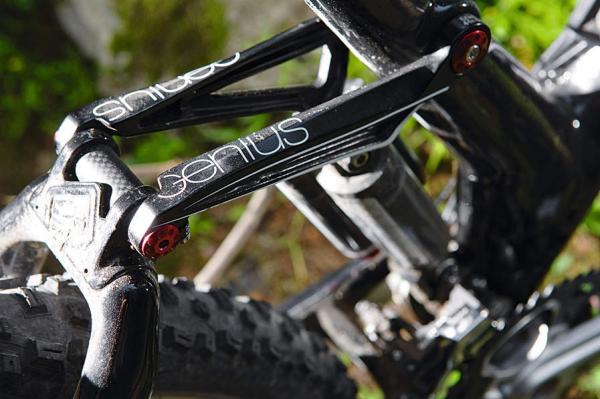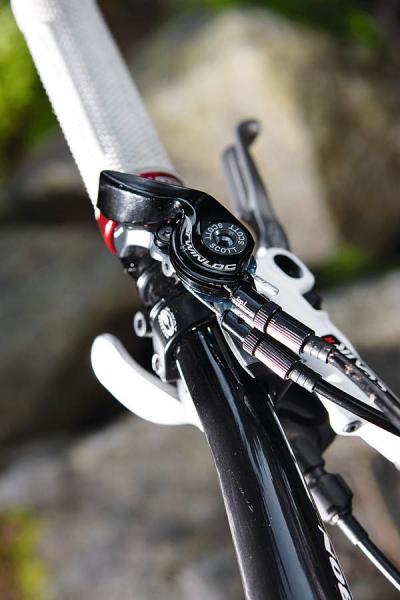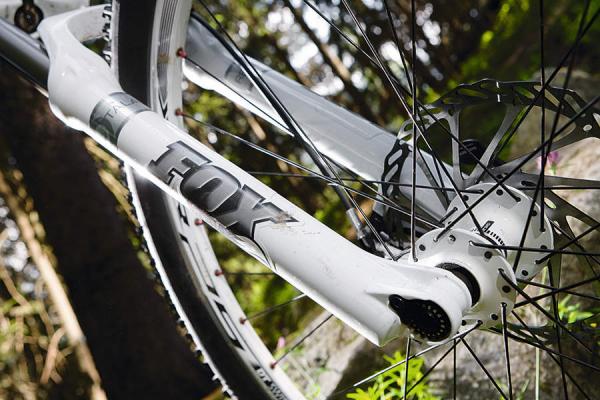You can trust Cyclingnews





Scott’s 2009 carbon-framed Genius created a stir in the long-travel trail bike camp by combining true lightweight performance with fingertip control of the rear shock via its proprietary handlebar-mounted Tracloc lever.
With an offering like this already on the table, it was dificult to see how Scott could improve the Genius for 2010. Indeed, the designers have left the Genius’s proven angles and beautiful frame construction well alone.
However, there has been another step forward: for 2010 the Genius and marathon–orientated 115mm travel Spark ranges are equipped with a new Twinloc lever that simultaneously adjusts the action of both fork and rear shock with a two-click push of a single bar-mounted thumb lever.
Ride & handling: Fast, light and with great geometry, this bike is well suited to marathon events
Right from the start, the Genius 20 is whippet-like in its approach to the trail. Its laterally stiff chassis and tight-feeling, centrally positioned shock transfer every ounce of effort into forward momentum. Attack fast singletrack and you’ll quickly identify with Scott’s race pedigree.
The action of the Twinloc lever is light and responsive, and while its handlebar positioning puts it out of the immediate line of fire for mud, the two cables will likely be subject to the ingress of water and grit. Fortunately the cables are easily unclamped to allow flushing through or replacement of the cable outer.

Fox and DT specced bikes such as the Genius 20 will need their forks returned to their respective service centres for cable replacement. This is a potential hassle, but the Twinloc cable shouldn’t need replacing more than once a year so it can be done when the fork is returned for its recommended annual service.
When riding the bike using the lever became almost automatic, and chasing the Scott team riders along Swiss singletrack and down through steep, twisting descents we found ourselves toggling between the limited-travel and full-travel modes, instantly adapting the Genius’ ride characteristics to the trail ahead.
Short sections of fire road and asphalt meant the lockout option allowed us to climb as on a rigid bike, and then instantly unlock fork and shock when diving back onto the trail.
In traction mode, the Genius 20 squats less and accelerates like a short-travel rig, and even a middle ring pedal-mashing chase failed to eke any noticeable bob out of the rear end.
The stiff, responsive mainframe and carbon rear triangle, combined with the accurate tracking through-axle Fox Talas 15 QR fork up front, delivers remarkable cornering accuracy on fast singletrack, making the bike feel like it’s running on rails.

The slack head angle, mated with the longish top tube and short 75mm stem, give the Genius a playful yet masterful identity that inspires conidence whether you’re swinging the bike through tight singletrack or using its full 6in of travel on step-filled descents.
The short stroke, high-pressure (in excess of 300psi) Equalizer shock lacks the small-hit plushness of some air/oil shocks out there, making fast, rocky descents a little skittish, but then that’s the price you pay for riding a sub-12kg 6in travel bike.
However, when the trail points skyward there’s not much that can reel the Genius in and, with a push on the Twinloc lever, the bike is transformed from a do-anything, all-day trail muncher to a sprightly race machine that would give roadies a run for their money.
The light weight of the front and rear Schwalbe Nobby Nic tyres helped acceleration while still being aggressive all-round treads that shed mud easily.
The Scott-branded white grips are fly but lock on inboard only and started twisting at the outer end of the bars – we’d prefer to see full lock-ons.

Chassis: Stiff and good-looking, with on-the-fly simultaneous shock and fork adjustment
The Genius 20 frame is unchanged from its ’09 predecessor, apart from new decals that give a black and white theme which complements the white hubs, rims, grips, saddle and fork.
The frame’s main triangle is a result of Scott’s proprietary Integrated Moulding Process (IMP), in which 130 pieces of carbon matting are laid up over an internal mould that’s then melted and withdrawn during the carbon curing process.
The result is Scott’s slant on the monocoque, in which the main tubes exist as a single continuous piece, flowing seamlessly into one another. The myriad cross-sectional shapes and tube diameters employed in the main triangle alone are testament to the huge amount of R&D that has gone into the Genius’s superlight (1.84kg/4.05lb without shock) and unashamedly stiff frame.
The Genius 20 has the same faux-bar suspension design employed throughout the Genius range and uses Scott’s own Equalizer-2 pull shock to keep things tracking smoothly at the back. The three chambers on the shock make it a fairly heavy (410g) piece of kit, but its location means the weight is unobtrusive.
The new Twinloc lever has three positions: in the first both rear shock and fork are open and active, allowing the full 6in of travel front and rear. The second position sets the rear shock in traction mode, limiting its travel to a climb-orientated 95mm, while leaving the fork fully open. The final position locks out both rear shock and fork, perfect for hardpack climbs. A second push-release lever sits beneath for instant return of the main lever to its previous position.
While the Twinloc easily finds its place on the shorter travel, race-orientated Spark range, it’s likely to be used less often on a trail-orientated rig like the Genius. Don’t get us wrong: the Twinloc performs admirably, but on the Genius it’s more a bonus than a necessity.